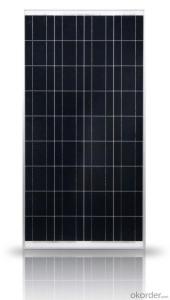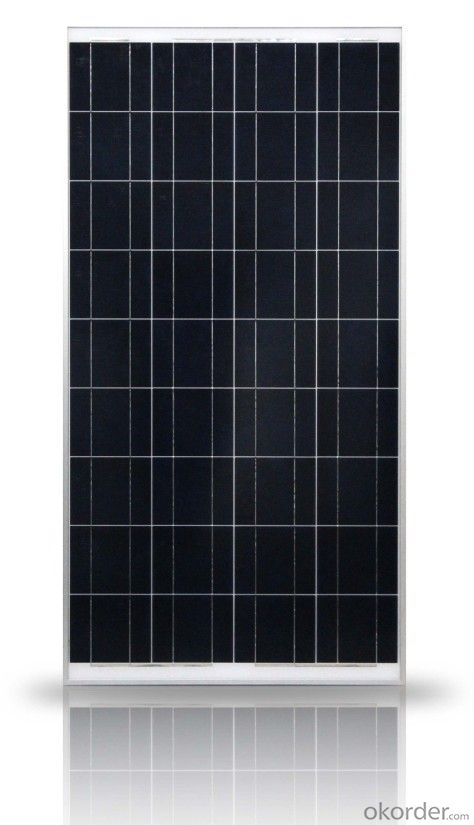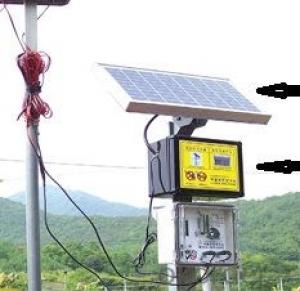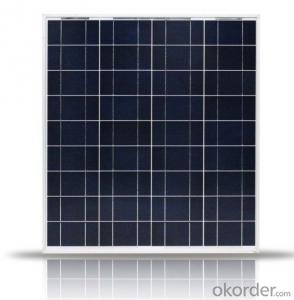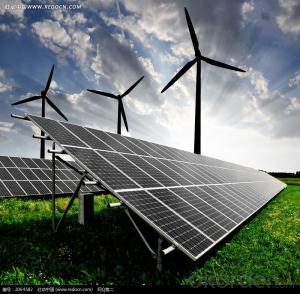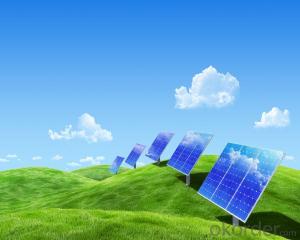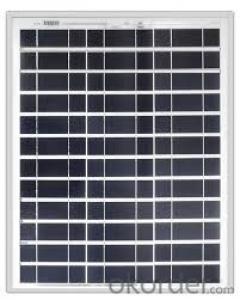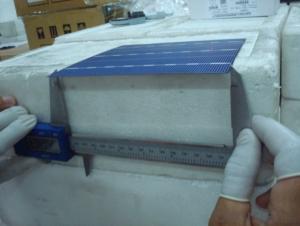Factory Direct Sale Poly Solar Panel with 25 Years Warranty CNBM - Solar Cells South Africa
- Loading Port:
- Qingdao
- Payment Terms:
- TT OR LC
- Min Order Qty:
- 10 set
- Supply Capability:
- 300000 set/month
OKorder Service Pledge
OKorder Financial Service
You Might Also Like
Polycrystalline Solar Modules
CNBM offers a range of small, medium and large polycrystalline solar modules, designed for a range of requirements.

Specifications:
Tolerance | +/-3% |
Cell | Polycrystalline silicon solar cells (156 x 156mm) |
N0. of Cells | 60 (10 x 6) |
Dimension of Modules (mm) | 1650 x 990 x 40 |
Weight (kg) | 25.5 |
Limits:
Operating Temperature | -40~+85? |
Storage Temperature | -40~+85? |
Maximum System Voltage | 1000 VDC max. |
Hail Impact | Diameter of 28mm with impact speed |
Temperature and Coefficients:
NOCT | 48C+/-2? |
Voltage temperature coefficient (%/K) | -0.35 |
Current temperature coefficient (%/K) | 0.05 |
Power temperature coefficient (%/K) | -0.45 |
Characteristics:
Model: | SGM-200P | SGM-210P | SGM-220P |
Max-power voltage Vmp (V) | 29.2 | 29.4 | 29.41 |
Max-power current Imp (A) | 6.85 | 7.14 | 7.48 |
Open-circuit voltage Voc (V) | 36.5 | 36.69 | 36.9 |
Short-Circuit Current Isc (A) | 7.28 | 7.6 | 7.93 |
Max-power Pm(W) | 200 | 210 | 220 |
Model: | SGM-230P |
Max-power voltage Vmp (V) | 29.8 |
Max-power current Imp (A) | 7.72 |
Open-circuit voltage Voc (V) | 37.31 |
Short-Circuit Current Isc (A) | 8.19 |
Max-power Pm(W) | 230 |
STC: Irradiance 1000W/m2, module temperature 25?, AM-=1.5
Poly Crystalline Solar Panels Specifications Range
Maximum Power (Pm) | Dimension | Weight | Operating Voltage (Vmp) | Operating Current (Imp) | Open Circuit Voltage (Voc) | Short Circuit Current (Isc) |
0.45W | 140x80x10mm | 0.08kg | 3.3V | 150mA | 4.6V | 160mA |
1.0W | 162x140x10mm | 0.16kg | 7.5V | 150mA | 10.3V | 160mA |
4.5W | 269x251x23mm | 0.8kg | 16.5V | 0.27A | 20.5V | 0.3A |
10W | 420.1×268.9×22.6mm | 1.92kg | 17.5V | 0.58A | 20.5V | 0.6A |
20W | 425x502x50mm | 3.0kg | 16.8V | 1.19A | 21.0V | 1.29A |
30W | 593x502x22.6mm | 3.9kg | 16.8V | 1.78A | 21.0V | 1.94A |
40W | 655x537x50mm | 5.75kg | 17.3V | 2.31A | 22.1V | 2.54A |
50W | 839x537x50mm | 6.0kg | 17.5V | 2.9A | 21.8V | 3.17A |
65W | 1111x502x50mm | 7.2kg | 17.6V | 3.69A | 22.1V | 3.99A |
80W | 1204x537x50mm | 7.7kg | 17.6V | 4.55A | 22.1V | 4.8A |
- Q: What is the maximum efficiency achievable by a solar cell?
- The maximum efficiency achievable by a solar cell is determined by the Shockley-Queisser limit, which states that the theoretical maximum efficiency is around 33.7%. However, in practice, most commercially available solar cells have efficiencies ranging between 15% to 22%.
- Q: How do solar cells perform in regions with high levels of humidity and rainfall?
- Solar cells can still perform well in regions with high levels of humidity and rainfall. While humidity may slightly decrease the efficiency of solar cells, modern designs and materials are developed to withstand these conditions. Additionally, rainfall can actually be beneficial as it helps to clean the solar panels, removing dust and dirt that may accumulate on the surface. Overall, solar cells can still generate electricity effectively in regions with high humidity and rainfall, although their performance may be slightly affected.
- Q: What is the role of surge suppressors in solar cell systems?
- The role of surge suppressors in solar cell systems is to protect the system from voltage spikes and surges caused by lightning strikes, power surges, or other electrical disturbances. These suppressors help in preventing damage to the solar panels, inverters, and other components of the system, ensuring their longevity and efficient operation.
- Q: Can solar cells be used for powering communication systems?
- Yes, solar cells can be used to power communication systems. Solar cells convert sunlight into electrical energy, which can then be used to power various electronic devices, including communication systems. This renewable source of energy is a sustainable and environmentally friendly option for powering communication systems, especially in remote or off-grid locations where access to traditional power sources may be limited.
- Q: What is the impact of snow accumulation on solar cells?
- Snow accumulation on solar cells can have a negative impact on their performance and efficiency. The layer of snow covering the cells prevents sunlight from reaching the surface, reducing the electricity generation capacity. Additionally, the weight of the snow can potentially damage the cells or the supporting structure. Regular cleaning or tilting of the panels can minimize the impact and ensure optimal solar energy production.
- Q: What is a good introduction of solar cell?
- In my opinion, a simple and interesting experiment would be a good start.
- Q: Can solar cells be used in residential applications?
- Yes, solar cells can be used in residential applications. They are commonly used to generate electricity for homes, providing a clean and renewable energy source. Solar panels are installed on rooftops or in yards, capturing sunlight and converting it into usable electricity for various household needs. This helps reduce reliance on traditional power grids and lowers carbon emissions, making it an environmentally friendly and cost-effective solution for residential energy needs.
- Q: How do solar cells perform in cloudy weather?
- Solar cells do not perform as efficiently in cloudy weather compared to sunny conditions, as they rely on direct sunlight to generate electricity. However, they can still generate some electricity, albeit at a reduced rate, as they can absorb diffuse sunlight and convert it into energy.
- Q: How can I buy the solar cells wholesale ?
- There are many OEM factories manufacturing solar cells in China. As long as your order is big enough, most of the OEM factories are willing to provide you a competitive whole sale price which is much cheaper than retail price.
- Q: How is the solar cells factories working in China? Do they follow certain quality standards?
- Yes, they follow the standard quality assurance protocol, and they are doing very well.
Send your message to us
Factory Direct Sale Poly Solar Panel with 25 Years Warranty CNBM - Solar Cells South Africa
- Loading Port:
- Qingdao
- Payment Terms:
- TT OR LC
- Min Order Qty:
- 10 set
- Supply Capability:
- 300000 set/month
OKorder Service Pledge
OKorder Financial Service
Similar products
Hot products
Hot Searches
Related keywords
